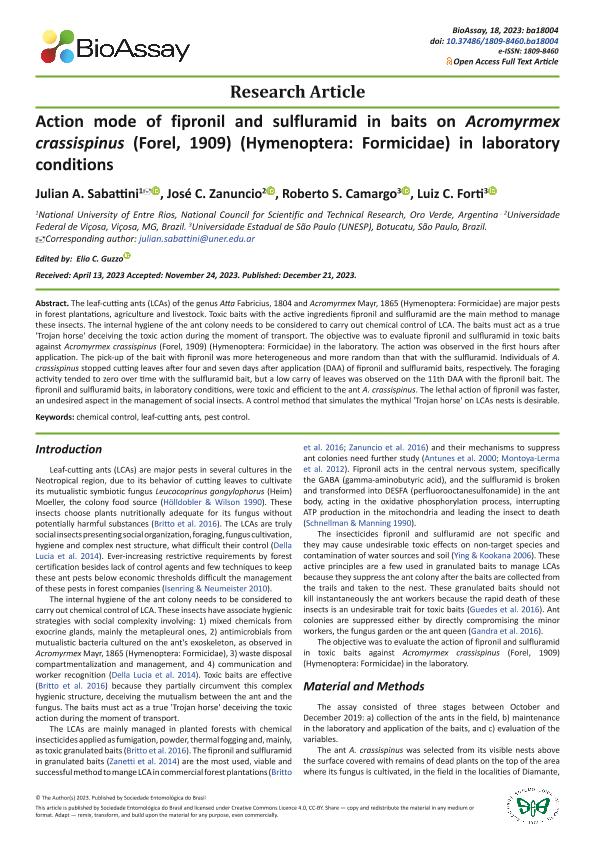Artículo
Action mode of fipronil and sulfluramid in baits on Acromyrmex crassispinus (Forel, 1909) (Hymenoptera: Formicidae) in laboratory conditions
Fecha de publicación:
12/2023
Editorial:
Sociedade Entomológica do Brasil
Revista:
BioAssay
e-ISSN:
1809-8460
Idioma:
Inglés
Tipo de recurso:
Artículo publicado
Clasificación temática:
Resumen
The leaf-cutting ants (LCAs) of the genus Atta Fabricius, 1804 and Acromyrmex Mayr, 1865 (Hymenoptera: Formicidae) are major pests in forest plantations, agriculture and livestock. Toxic baits with the active ingredients fipronil and sulfluramid are the main method to manage these insects. The internal hygiene of the ant colony needs to be considered to carry out chemical control of LCA. The baits must act as a true ´Trojan horse´ deceiving the toxic action during the moment of transport. The objective was to evaluate fipronil and sulfluramid in toxic baits against Acromyrmex crassispinus (Forel, 1909) (Hymenoptera: Formicidae) in the laboratory. The action was observed in the first hours after application. The pick-up of the bait with fipronil was more heterogeneous and more random than that with the sulfluramid. Individuals of A. crassispinus stopped cutting leaves after four and seven days after application (DAA) of fipronil and sulfluramid baits, respectively. The foraging activity tended to zero over time with the sulfluramid bait, but a low carry of leaves was observed on the 11th DAA with the fipronil bait. The fipronil and sulfluramid baits, in laboratory conditions, were toxic and efficient to the ant A. crassispinus. The lethal action of fipronil was faster, an undesired aspect in the management of social insects. A control method that simulates the mythical ´Trojan horse´ on LCAs nests is desirable.
Palabras clave:
CHEMICAL CONTROL
,
LEAF-CUTTING ANTS
,
PEST CONTROL
Archivos asociados
Licencia
Identificadores
Colecciones
Articulos(SEDE CENTRAL)
Articulos de SEDE CENTRAL
Articulos de SEDE CENTRAL
Citación
Sabattini, Julian Alberto; Zanuncio, Jose C.; Camargo, Roberto S.; Forti, Luiz C.; Action mode of fipronil and sulfluramid in baits on Acromyrmex crassispinus (Forel, 1909) (Hymenoptera: Formicidae) in laboratory conditions; Sociedade Entomológica do Brasil; BioAssay; 18; 12-2023; 1-5
Compartir
Altmétricas




